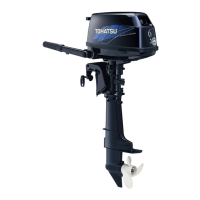3-12
Maintenance
4st 4/5/6 2011
6. Fully open throttle, crank engine until compression gauge 2
indication stabilizes, and then measure compression
pressure.
7. If compression pressure is below specified value, put small
amount of engine oil into cylinder, and perform the test again.
Compression Pressure (Reference) : 500 r/min
With decompressor : 0.34 MPa (49.3 psi) [3.5 kgf/cm
2
]
±10%
Without decompressor : 0.93 MPa (137.8 psi) [9.5 kgf/cm
2
] ±10%
(*Remove Exhaust rocker arm)
· If compression pressure increases after the
above measure, check pistons and piston rings
for wear. Replace if necessary.
· If compression pressure does not increase
after the above measure, check valve
clearances, valves, valve seats and cylinder
head. Adjust or replace if necessary.
4. Remove all plug caps and then all spark plugs.
5. Install compression gauge 2 to plug hole.
11) Inspection of Compression Pressure
1. Start and run engine for 5 minutes to warm up, and then
stop.
2. Shift gear into neutral (N).
3. Remove lock plate 1 (of stop switch lanyard) from stop
switch.
· Compression pressure is affected much by
cranking speed, and normally changes
approximately 10%.
· Do not pull choke knob when measuring
compression pressure.
Clean areas around spark plugs on the
cylinder before removing spark plugs to
prevent dirt from entering cylinder.
Compression Gauge 2 :
P/N. 3AC-99030-0
Remove lock plate (of stop switch lanyard)
from stop switch before measuring
compression pressure. This will prevent
engine from accidental starting.
MFS4-5-6Ech03110422.qxd 11.4.22 5:45 PM ページ12

